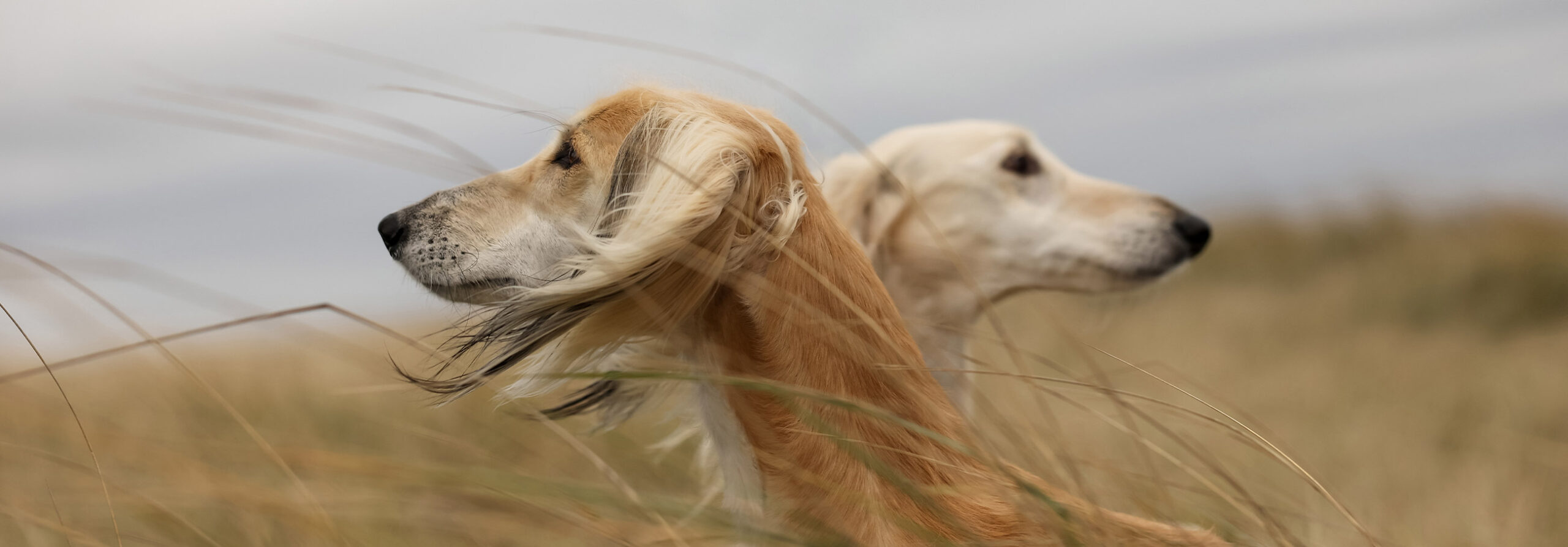The way the story goes, in my family, is that when I was just an infant, my mother was pushing me in an old fashioned baby carriage on the streets near our apartment in New York City, when she spotted a fashionably eccentric woman walking a small pack of incredibly beautiful dogs. My mother had had a mutt as a child and then a toy poodle as a young woman but was not particularly knowledgeable about the various breeds — but she was so captivated by the sight of these dogs that she began hurrying after the woman, pushing me in the carriage in front of her. The woman began to run herself, thinking she was being chased by a crazy person — but eventually my mother caught up with her and convinced the woman, whose name was Judith Rothschild Myrer, that she was harmless and only wanted to know about the dogs. This was my introduction to salukis.
Judith was very hesitant about recommending salukis to a young mother with a toddler — at the time, in the mid 1960s, salukis were, generally speaking, not that well mannered, not easily approachable, and not to be immediately trusted with strangers or children. But a few years later, my mother was able to get a saluki from a breeder in Connecticut — though I can find no record of his pedigree or registration. Mostly what I recall is that he was a big sable red dog who pulled me over into the dirt when I walked him before and after school — and who liked to run after anything that moved when I let him off leash at our house by the beach, often disappearing for long stretches of time before coming back to sleep in my bed. Many years later, in 1988, Judith Myrer called me — as if out of the blue — to tell me she had a litter of puppies: was I interested? I am not sure I realized that I was stepping into much more than just a puppy. The dog, Alpha Omega Korbu, was a very stylish cream dog — probably not the soundest mover — but what did I know at first? Judith had devoted herself to the breed, published a magazine for many years that was the pre-eminent saluki forum, and had established a distinct breeding program based on old, foundational stock from saluki breeders in England and Europe, most especially the Burydown lines of Mrs. Hope Waters. Over time, Judith showered me with reading material, photographs and pedigrees — and I soaked every bit in that I could, reaching out to breeders around the world, all of whom in various ways contributed to my growing base of knowledge regarding type and breeding systems. And she convinced me to show my dog. Like many or most new exhibitors, I certainly struggled to finish Korbu — but finally with help from excellent handling instructors and other exhibitors I did. And soon I had another puppy, Alpha’s Arcadia, Katie, a lovely cream bitch, that I finished rather quickly and convincingly.
When Judith told me about a litter of puppies in Sweden that had been bred by Bjorn and Birgitta Backstroke, that went back to so many of the pedigrees that I had fallen in love with — Samoens, Burydown, El Hamrah — I jumped at the opportunity! And the Backstrokes delivered Stryker to me in New York — where he jumped proudly on my couch as if he knew he belonged. Stryker was a real showman — and I had my first real taste of success in the breed and group rings with him. And I bred Katie to Stryker — my first litter of puppies, born April 1994. Unfortunately, Judith did not live to see these puppies — but I was very blessed to have become close friends with Cathy Diener Farrell, whose Gemini salukis also came down largely from Judith’s lines, and she and I have been dreaming about and discussing salukis — and bringing them to life — ever since.
There was one truly exceptional dog in this litter, Phaeton James Stirling — and even though he was shown and used sparingly his impact on the breed is still seen today. He is the sire of 3 stunning bitches — all from different dams: CH Gemini Phaeton Jane Eyre, CH Windstorm Ruffled One, and GCHS Phaeton Kallalily of Haefen — with so many titles, best in shows and best in specialty wins between them that the list would go on and on — and two terrific dogs, CH Windstorm A Sandchris Rhapsody and CH Haefen Phaeton Kaspian — that also have a rich trove of titles and specialty wins. Stirling still remains a kind of vision for me. With his regal, sculpted head, the unusual black sabling in his white furnishings which gave him his namesake silvery appearance, his stallion-like body and carriage, his light, lifting and effortless motion, and his limitless companionship and devotion to me — I still picture him as the very representation of both the standard and of true type. He was and is, to me the epitome of a priceless, royal dessert hunter and belongs in every way in the pantheon alongside the Arab horse and the falcon.



